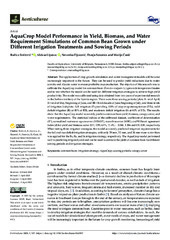Приказ основних података о документу
AquaCrop Model Performance in Yield, Biomass, and Water Requirement Simulations of Common Bean Grown under Different Irrigation Treatments and Sowing Periods
| dc.creator | Stričević, Ružica | |
| dc.creator | Lipovac, Aleksa | |
| dc.creator | Djurović, Nevenka | |
| dc.creator | Sotonica, Dunja | |
| dc.creator | Ćosić, Marija | |
| dc.date.accessioned | 2023-12-29T10:31:47Z | |
| dc.date.available | 2023-12-29T10:31:47Z | |
| dc.date.issued | 2023 | |
| dc.identifier.issn | 2311-7524 | |
| dc.identifier.uri | https://www.mdpi.com/2311-7524/9/4/507 | |
| dc.identifier.uri | http://aspace.agrif.bg.ac.rs/handle/123456789/6697 | |
| dc.description.abstract | first_pageDownload PDFsettingsOrder Article Reprints Open AccessArticle AquaCrop Model Performance in Yield, Biomass, and Water Requirement Simulations of Common Bean Grown under Different Irrigation Treatments and Sowing Periods by Ružica Stričević *ORCID,Aleksa LipovacORCID,Nevenka Djurović,Dunja Sotonica andMarija Ćosić Faculty of Agriculture, University of Belgrade, Nemanjina 6, 11080 Zemun, Serbia * Author to whom correspondence should be addressed. Horticulturae 2023, 9(4), 507; https://doi.org/10.3390/horticulturae9040507 Submission received: 13 March 2023 / Revised: 11 April 2023 / Accepted: 13 April 2023 / Published: 19 April 2023 (This article belongs to the Special Issue Integrated Water Resources Management for Horticulture) Downloadkeyboard_arrow_down Browse Figures Review Reports Versions Notes Abstract The application of crop growth simulation and water management models will become increasingly important in the future. They can be used to predict yield reductions due to water scarcity and allocate water to ensure profitable crop production. The objective of this research was to calibrate the AquaCrop model for common bean (Faseolus vulgaris L.) grown in temperate climates and to test whether the model can be used for different irrigation strategies to achieve high yield productivity. The model was calibrated using data obtained from two years of experimental research in the Serbian territory of the Syrmia region. There were three sowing periods/plots: I—mid April, II—end of May/beginning of June, and III—third decade of June/beginning of July; and three levels of irrigation/subplots: full irrigation (F) providing 100% of crop evapotranspiration (ETc), mild deficit irrigation (R) at 80% of ETc, and moderate deficit irrigation (S) at 60% of ETc. The results show that the AquaCrop model accurately predicts common bean yield, biomass, canopy cover, and water requirements. The statistical indices of the calibrated dataset, coefficient of determination (R2), normalized root mean square error (NRMSE), mean bias error (MBE), and Willmott agreement index (d) for yield and biomass were: 0.91, 0.99; 6.9%, 11.4%; −0.046, 1.186 and 0.9, 0.89, respectively. When testing three irrigation strategies, the model accurately predicted irrigation requirements for the full and two deficit irrigation strategies, with only 29 mm, 32 mm, and 34 mm more water than was applied for the Fs, Rs, and Ss irrigation strategy, respectively. The AquaCrop model performed well in predicting irrigated yield and can be used to estimate the yield of common bean for different sowing periods and irrigation strategies. | sr |
| dc.language.iso | en | sr |
| dc.publisher | MDPI | sr |
| dc.relation | info:eu-repo/grantAgreement/MESTD/inst-2020/200116/RS// | sr |
| dc.rights | openAccess | sr |
| dc.rights.uri | https://creativecommons.org/licenses/by/4.0/ | |
| dc.source | Horticulturae | sr |
| dc.subject | common bean | sr |
| dc.subject | irrigation strategy | sr |
| dc.subject | AquaCrop | sr |
| dc.subject | sowing periods | sr |
| dc.subject | canopy cover | sr |
| dc.title | AquaCrop Model Performance in Yield, Biomass, and Water Requirement Simulations of Common Bean Grown under Different Irrigation Treatments and Sowing Periods | sr |
| dc.type | article | sr |
| dc.rights.license | BY | sr |
| dc.citation.epage | 13 | |
| dc.citation.issue | 4 | |
| dc.citation.rank | M21~ | |
| dc.citation.spage | 1 | |
| dc.citation.volume | 9 | |
| dc.identifier.doi | 10.3390/horticulturae9040507 | |
| dc.identifier.fulltext | http://aspace.agrif.bg.ac.rs/bitstream/id/25432/bitstream_25432.pdf | |
| dc.type.version | publishedVersion | sr |


